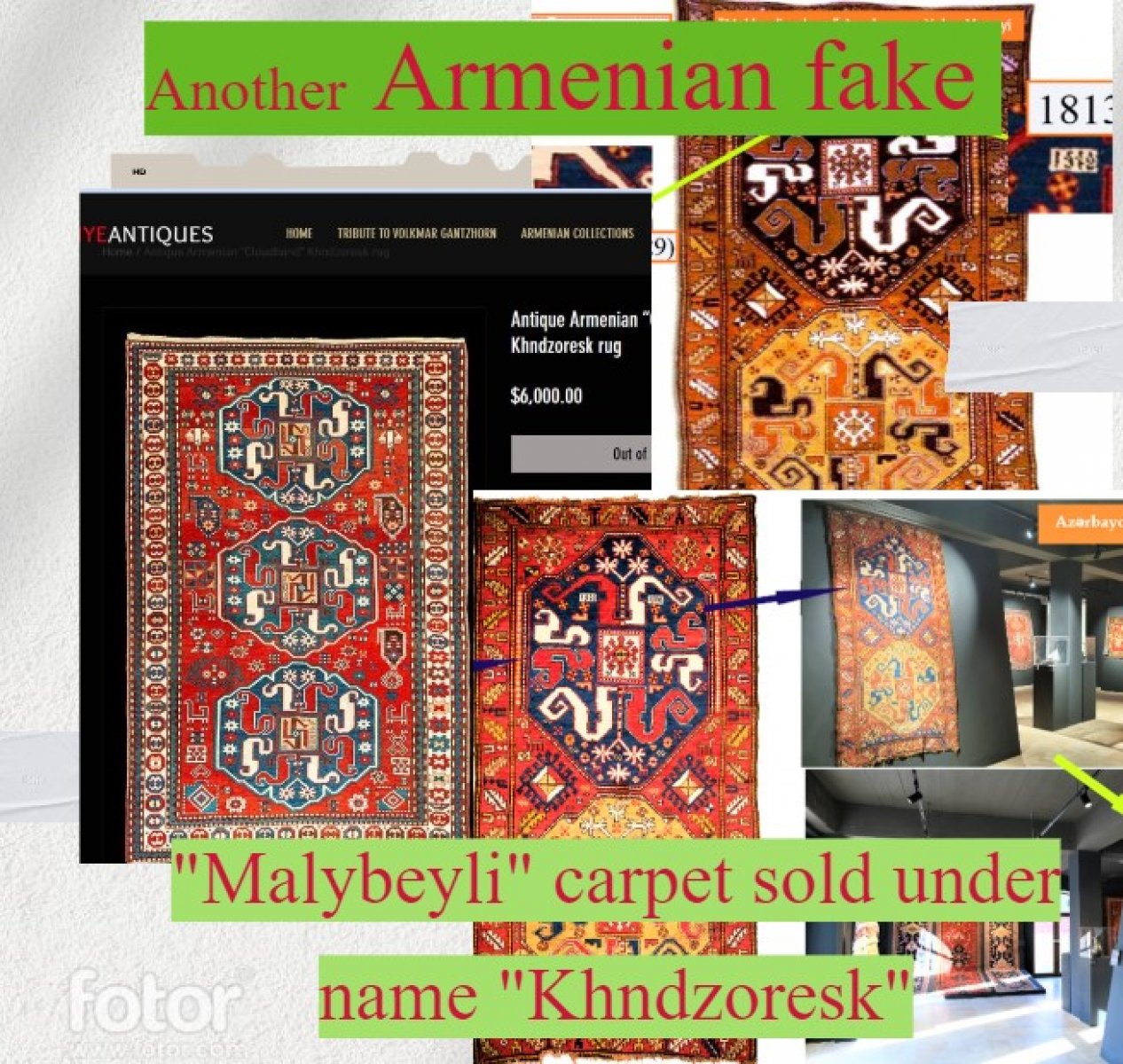
Journalist of Armenian origin Liana Margaryan, living in France, shared a photo called “Artsakh carpet” on the “X” platform (formerly Twitter).
Faktyoxla Lab. (Factcheking LAB.)has tried to find out if it was really an Armenian carpet.
After conducting a reverse search on the photograph, we discovered that the real name of the rug was “Malibeyli.”
Currently, the carpet is kept in the National Carpet Museum of Azerbaijan under the code INV 3341: “Malybeyli”. Karabakh, Azerbaijan. 1229 AH/1813 AD Arish, argay, hov-yun."

It turns out that the Azerbaijan Carpet Museum bought the Malibeyli carpet in 1976 from a resident of Karabakh, Ali Ahmed oglu Farruhi.
Looking closely at the carpet, one can see the date and name of the author on it. On the left is written ١٢٢٩ (1229) in Arabic alphabet, and on the right in Roman numerals is 1813. On the upper left side of the carpet you can see the inscription هليلح (Khalila), written in the Arabic alphabet. It is very likely that "Khalila" was the name of the person who wove the carpet.
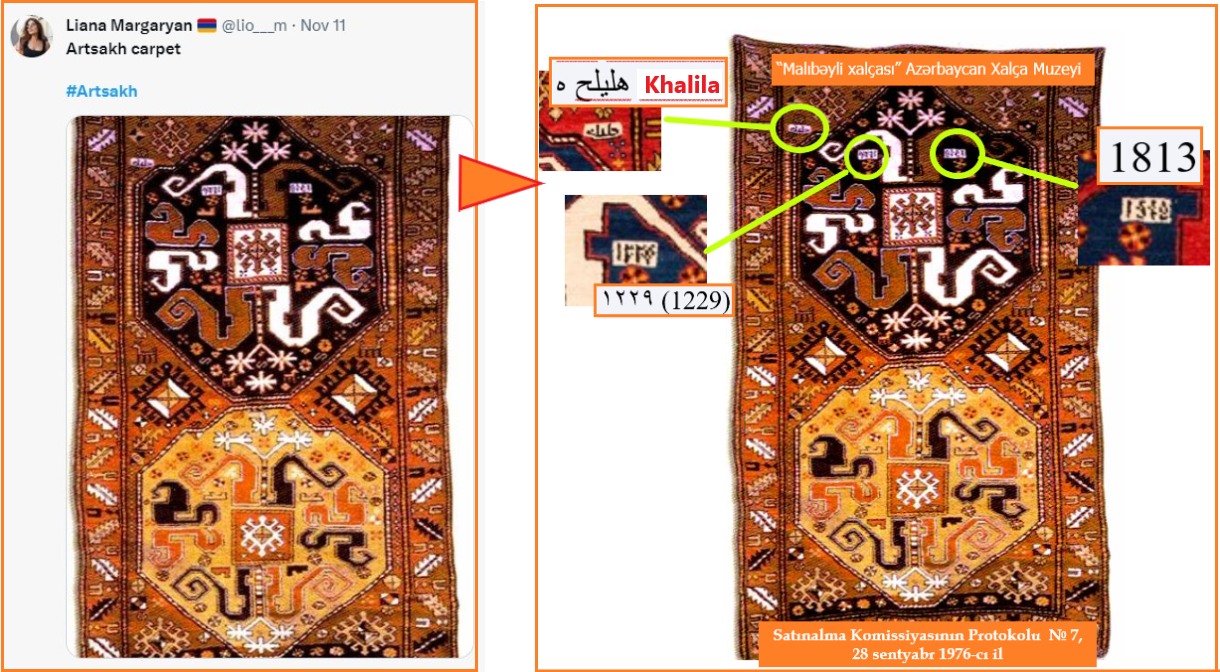
A number of foreign sources also confirm that this carpet is a Malibeyli carpet:
- “Album of technical drawings of carpets”, published by the “Caucasian Craft Committee” (St. Petersburg, 1912)
- “Carpet Album” of the Joint Stock Company “ZakKostorg” (Tbilisi, 1928).
- Ethnographic review by M. D. Isayev “Carpet production in Transcaucasia at the beginning of the 20th century” (M. D. Isayev “Carpet production in Transcaucasia.” Tbilisi, 1932).
Where did the name "Malibeyli" come from?
As for the “Malybeyli” carpets, the popularized Armenian name “Khndzoresk” appeared after the occupation of Karabakh. It is impossible to find a single serious source about Caucasian carpets before 1990, where this carpet would be called Khndzoresk.
Carpet exhibitions, the release of catalogs and the sale of replicas of the Malybeyli carpet with the name “Khndzoresk” were aimed at legitimizing the Armenian origin of this carpet.
The authentic name of the carpets comes from the name of the village of Malybey, where they were traditionally woven starting from the mid-18th century.
This village was 14 km away from the city of Shusha. The name of the village literally translates as belonging to Mali Bey. The name of this village appears in the 1912 Caucasian calendar. This Calendar reports that the population of the village is Tatar (Azerbaijani), 1060 people live in the village.
The village of Malybey was marked on maps of the Elizavetpol Province of the Russian Empire. There is information about this village in the Cameral Description of the Province (1859-1864).
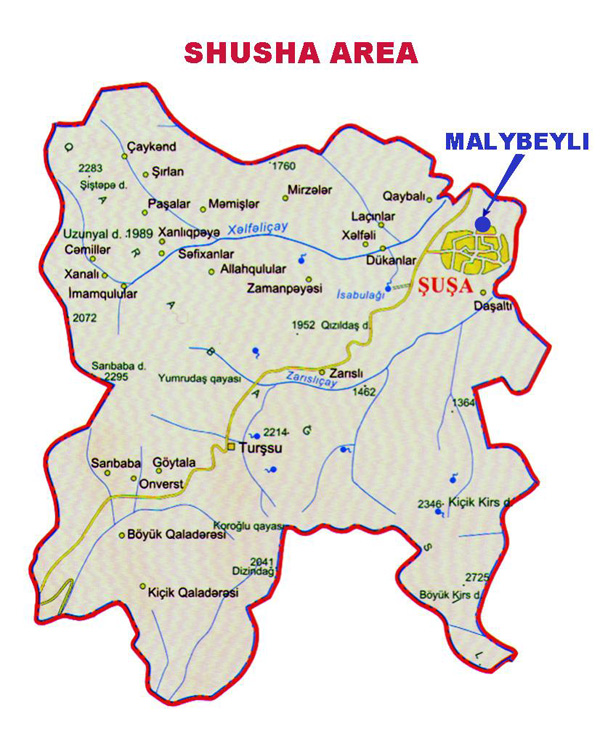
The magazine “Caucasian Almanac” wrote: “The Malibeyli dynasty, descendants of Mali Bey, were compactly located in the Shusha region and, like the residents of other villages, were engaged in animal husbandry, agriculture and carpet weaving since ancient times. (1912). In this village, bags, khurjun, saddle cover, etc. are widely used in everyday life and agriculture. The village is famous for its carpet production. The Malibeyli carpet spread from the village of Malybeyli and later influenced other carpet-weaving settlements in Karabakh.
After the occupation of the village by the Armenian armed forces in 1990, the village itself was destroyed, about 50 Azerbaijani civilians were killed, more than 100 people were injured or captured. Link

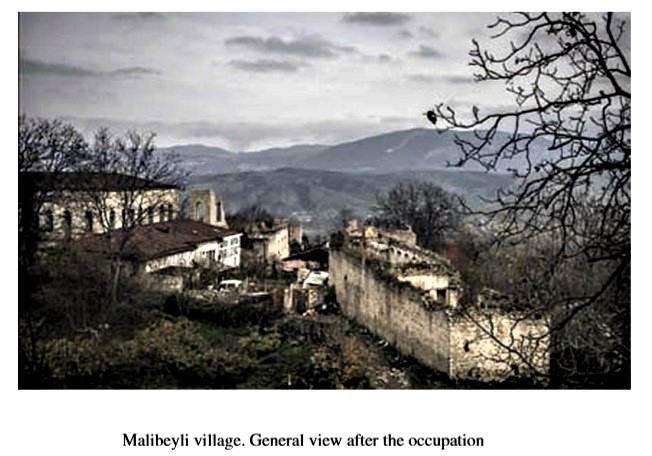
After the occupation, the name of the village was changed to “Yiernavank”.
As a result of the study, it turned out that only after the occupation in Armenian sources, as well as at antique auctions and in online sales centers selling carpets, carpets identical to the “Malybeyli” carpet began to appear under the name “Khndzoresk”.
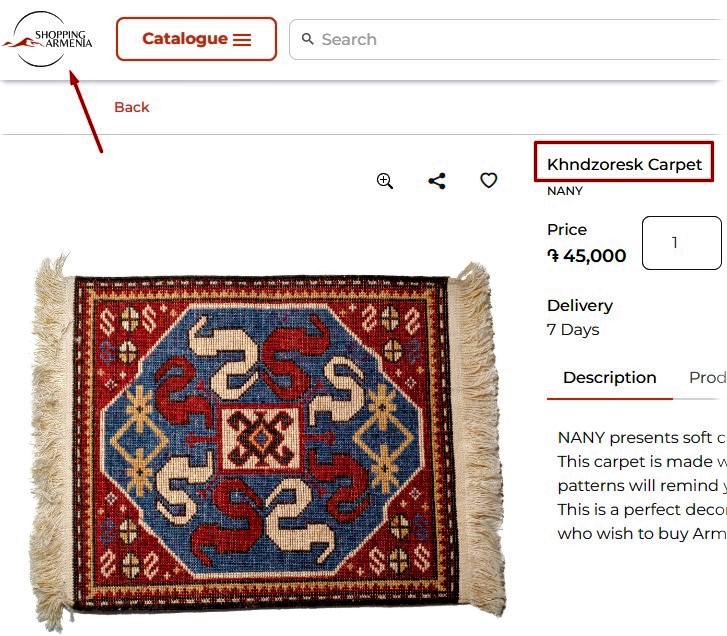
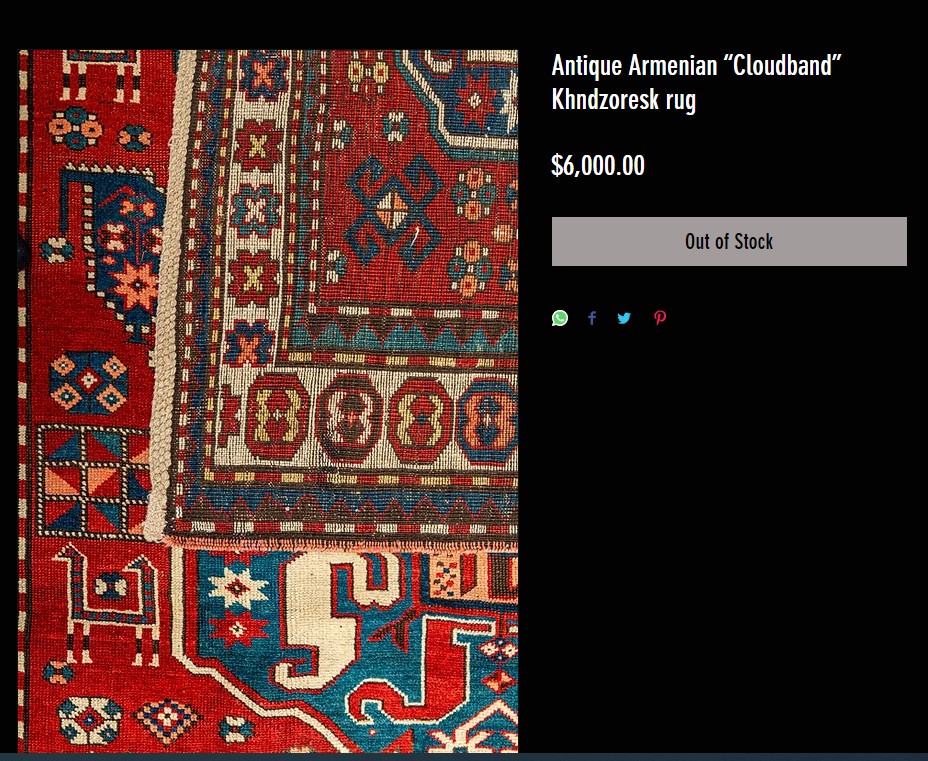
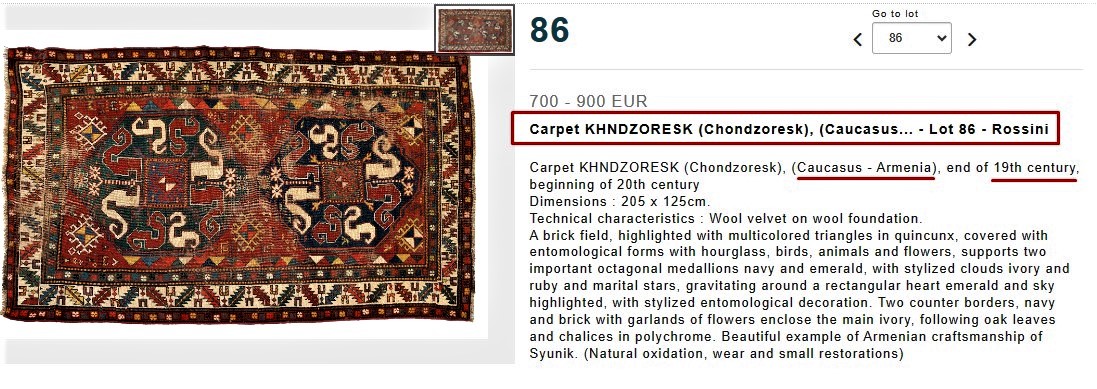
Firstly, the village of Khndzoresk has nothing to do with Karabakh from a geographical point of view. This is a village in the Goris district of Western Zangazur.
Secondly, no serious source until 1990 had discovered a carpet called “Khndzoresk”.
Let us pay attention to the interpretation of the elements and motifs of both carpets:
- The composition of the middle part of the “Malybeyli” carpet is made up of symbolic elements of the carpet, like a gol (lake), located in a vertical direction. These lakes have original artistic features. These patterns are the same in shape no matter where the rug is located in the middle zone. In the center of each lake there is a square element, creating the image of a pool, and the squares themselves are surrounded by serpentine elements, shaped like patterns, creating the image of a cloud.
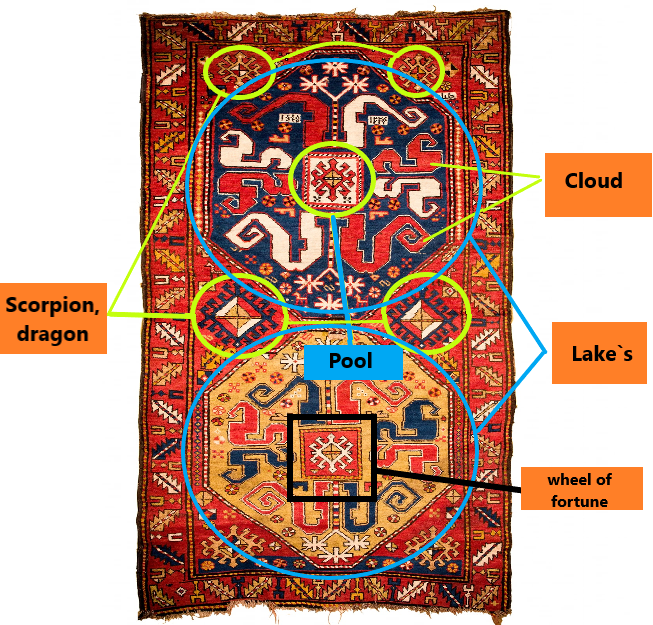
Pentagrams symbolize water. In the countries of the Middle East and Azerbaijan, water was depicted in the form of a fish, a duck, straight and wavy lines or parts thereof. The image of a cloud and other decorative elements of Uyghur-Chinese art, which became widespread, especially in miniatures and ceramics, spread into Azerbaijani folk art from the 9th century.
Apparently, this motif symbolizes flowing waters, the movement of clouds across the sky and “the good dragon sent by God to control the rain and waters” (L. Kerimov “Azerbaijan Carpet”, 2nd volume, 1983: 84). The square in the center of the medallions depicts a “wheel-star”. The combined use of these motifs is a manifestation of the idea of a pair of dragons turning the “wheel of fortune” in ancient Turkic mythology (Coruhlu, 2000, p. 133).
The reason why Azerbaijani art accepts these elements so easily is due to local social conditions, religious beliefs and lifestyles of the population, as well as the location of these countries on the “Silk Road”. In Malibeyli carpets, the background of the middle part is usually red, which is due to the abundance of the local madder plant, which is used to obtain the red color. Loop density: from 37x37 to 42x42, pile height 7-9 mm. (Source: L. Kerimov “Azerbaijan Carpet”, 3rd volume, p. 204.)
- First of all, neither the art of carpet weaving nor even the local tradition has been preserved in Armenia. Moreover, in the carpets with the dragon motif there are no Armenian traces, nor any fragment of various decorative and applied arts appropriated by the Armenians, nor a single detail showing any connection with architectural ornaments.
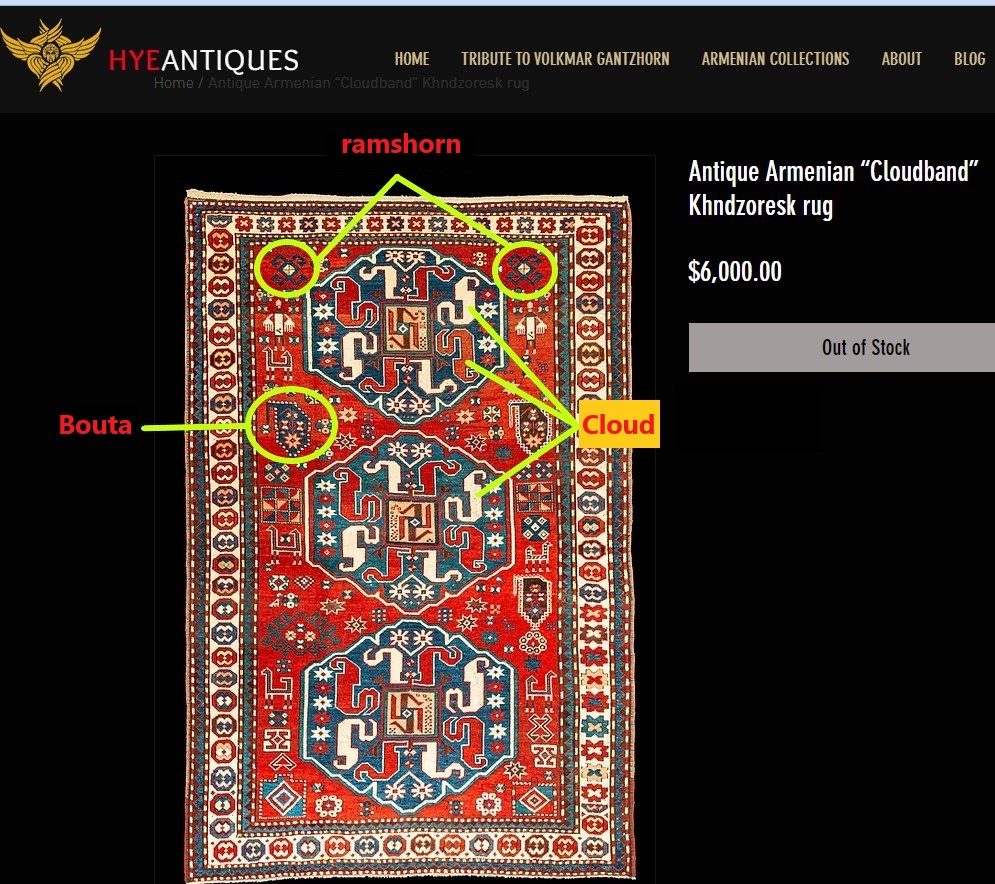
Foreign experts also confirm these ideas.
The famous American researcher and scientist Arthur Pope in his article “Myth of Armenian Dragon Carpet” writes that there is no significant evidence that Dragon carpets are of Armenian origin, but there is enough evidence about the impossibility of weaving such type of carpets on the territory of Armenia. (Pope A. The myth of the Armenian dragon carpet / Leipzig, 1925. P. 150, 152.)
M.D. Isayev in his work “Carpet Art in the South Caucasus” notes that carpet weaving is more widespread in the area densely populated by Azerbaijanis around Lake Goycha. (Isayev M.D. Carpet production in Transcaucasia. Tiflis, 1932. P. 127-128.)

Caucasus expert Y. Sedgenidze writes that the population of the city of Shusha (Karabakh) is predominantly Azerbaijanis. They mainly engage in weaving. The Armenians had to learn carpet weaving from them. (Sedgenidze Y. Production of carpets and rugs in the city of Shusha, Yelizovetpol province. 1891. Issue 11. P. 3)
George O. Bannon, an American scholar who studied the Shusha group of carpets, studied two carpets woven by Armenians and Kurds and wrote that they were transferred forms of carpets woven by Azerbaijanis. However, carpets with face transfer are not very successful; they are inferior to Azerbaijani carpets in terms of artistic, technical and color solutions. (Source: Oriental Rug Review, April/May 1990, pp. 12-16.)
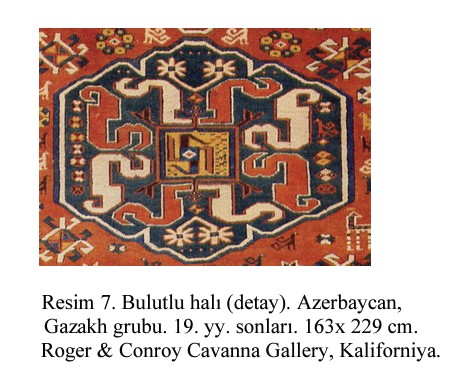
Conclusion:
- The carpet on the photo by Liana Margaryan and other Armenian propagandists has nothing to do with Armenians.
- The name of the carpet is “Malybeyli”, the date and name of the weaver are engraved on it.
- The Khndzoresk carpet, which Armenians brought to the world market after the 90s, is a modified form of the Malibeyli carpet.




















